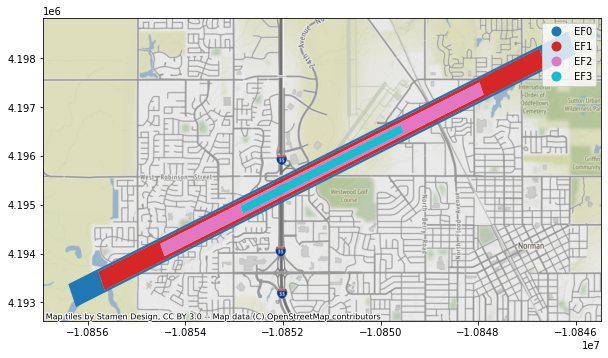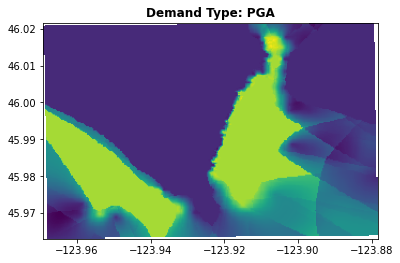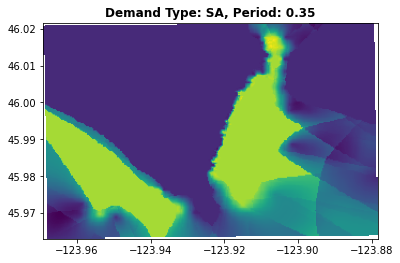Session 2: Assignment Answer#
Create the following hazards with given information and get hazard values from created hazards
a model-based tornado
a dataset-based earthquake
Please follow the instruction at each cell.
1. A model-based tornado#
Using the data from section 2.2, slightly alter the values of the Centerville tornado and obtain a new set of parameters that differ from the previously seen examples.
Tornado model definition:
Tornado Model: MeanWidthTornado
EF Rating: EF3
Start point of path:
Latitude:
Longitude:
End point of path:
Latitude:
Longitude:
Wind speed method: 1
number of simulation: 1
random seed: 2021
After you have obtained them, proceed as shown during the session.
# Import modules
from pyincore import HazardService, IncoreClient
import json
# Connect to IN-CORE serivce by creating IncoreClient
client = IncoreClient()
# Create the HazardService object
hazardsvc = HazardService(client)
Enter username: vnarah2
Enter password: ········
Connection successful to IN-CORE services. pyIncore version detected: 0.9.3
# TODO: create a JSON (dictionary) definition of tornado model as given above
my_tornado_model = {
"name": "Centerville Model Tornado - workshop exercise",
"description": "Centerville mean width tornado hazard",
"tornadoType": "model",
"tornadoModel" : "MeanWidthTornado",
"tornadoParameters" : {
"efRating" : "EF3",
"startLatitude" : "35.215",
"startLongitude" : "-97.524",
"randomSeed" : "2021",
"endLatitude" : [35.253],
"endLongitude" : [-97.432],
"windSpeedMethod" : "1",
"numSimulations" : "1"
}
}
tornado_model_json = json.dumps(my_tornado_model)
# TODO: create a tornado with definition
model_response = hazardsvc.create_tornado_scenario(tornado_model_json)
# TODO: acquire hazard id you created and visualize
tornado_model_id = model_response["id"]
from pyincore_viz.geoutil import GeoUtil as viz
viz.plot_tornado(tornado_model_id, client, basemap=True)

# TODO: Getting and printing hazard value from your tornado
points = [
{
"demands": ["wind"],
"units": ["mph"],
"loc": "35.215, -97.521"
},
{
"demands": ["wind"],
"units": ["mph"],
"loc": "35.228, -97.490"
}
]
tornado_model_vals = hazardsvc.post_tornado_hazard_values(tornado_model_id, points)
print(json.dumps(tornado_model_vals, indent=4, sort_keys=False))
[
{
"hazardValues": [
65.19653087157995
],
"demands": [
"Wind"
],
"units": [
"mph"
],
"loc": "35.215, -97.521"
},
{
"hazardValues": [
111.23396532330945
],
"demands": [
"Wind"
],
"units": [
"mph"
],
"loc": "35.228, -97.49"
}
]
2. A dataset-based earthquake#
Now, using the dataset-driven earthquake definition seen in section 3.3, define a new earthquake hazard.
Geotiff files are provided in the folder and here are description of each GeoTiff:
pga-prob.tif
hazard type:
demand type:
demand unit:
period:
recurrenceInterval: 50
recurrenceUnit: years
sa-035-prob.tif
hazard type:
demand type:
demand unit:
period:
recurrenceInterval: 50
recurrenceUnit: years
Note - since these are probabilistic earthquake hazards, eqParameters is not part of the description and is replaced by recurrence information. The rest is the similar to section 3.3. A complete dataset-driven hazard consists of these two files.
Proceed as in the prior exercise.
# TODO: create a JSON (dictionary) definition of dataset-based earthquake
my_eq_dataset = {
"eqType": "dataset",
"name": "Sample Probabilistic EQ 50yr - workshop",
"description": "Dataset based probabilistic earthquake hazard 50yr",
"hazardDatasets": [
{
"hazardType": "probabilistic",
"demandType": "PGA",
"demandUnits": "g",
"period": 0,
"recurrenceInterval": 50,
"recurrenceUnit": "years"
},
{
"hazardType": "probabilistic",
"demandType": "SA",
"demandUnits": "g",
"period": 0.35,
"recurrenceInterval": 50,
"recurrenceUnit": "years"
}
]
}
eq_dataset_json = json.dumps(my_eq_dataset)
file_paths = ["pga-prob.tif", "sa-035-prob.tif"]
# TODO: create a earthquake with definition and files
eq_dataset_response = hazardsvc.create_earthquake(eq_dataset_json, file_paths)
print(json.dumps(eq_dataset_response, indent=4, sort_keys=False))
{
"eqType": "dataset",
"id": "60ac6acb09212c7553ed92d7",
"name": "Sample Probabilistic EQ 50yr - workshop",
"description": "Dataset based probabilistic earthquake hazard 50yr",
"date": "2021-05-25T03:11:06+0000",
"creator": "vnarah2",
"spaces": [
"vnarah2"
],
"hazardDatasets": [
{
"hazardType": "probabilistic",
"datasetId": "60ac6aca93b4f34f0bf2922f",
"demandType": "PGA",
"demandUnits": "g",
"period": 0.0,
"recurrenceInterval": 50,
"recurrenceUnit": "years"
},
{
"hazardType": "probabilistic",
"datasetId": "60ac6acbc157585793efc84e",
"demandType": "SA",
"demandUnits": "g",
"period": 0.35,
"recurrenceInterval": 50,
"recurrenceUnit": "years"
}
]
}
# TODO: acquire hazard id you created and visualize
eq_dataset_id = eq_dataset_response['id']
viz.plot_earthquake(eq_dataset_id, client, "PGA")
viz.plot_earthquake(eq_dataset_id, client, "0.35 SA")
/Users/vnarah2/opt/miniconda3/envs/pyincore/lib/python3.7/site-packages/matplotlib/image.py:487: RuntimeWarning: overflow encountered in true_divide
A_scaled /= ((a_max - a_min) / frac)


# TODO: Getting and printing hazard value from your tornado
points = [
{
"demands": ["0.35 SA"],
"units": ["g"],
"loc": "46.00, -123.94"
},
{
"demands": ["PGA"],
"units": ["g"],
"loc": "45.98, -123.90"
},
]
eq_dataset_vals = hazardsvc.post_earthquake_hazard_values(eq_dataset_id, points)
print(json.dumps(eq_dataset_vals, indent=4, sort_keys=False))
[
{
"hazardValues": [
1.149999976158142
],
"demands": [
"0.35 SA"
],
"units": [
"g"
],
"loc": "46.0, -123.94"
},
{
"hazardValues": [
1.2269784212112427
],
"demands": [
"PGA"
],
"units": [
"g"
],
"loc": "45.98, -123.9"
}
]
